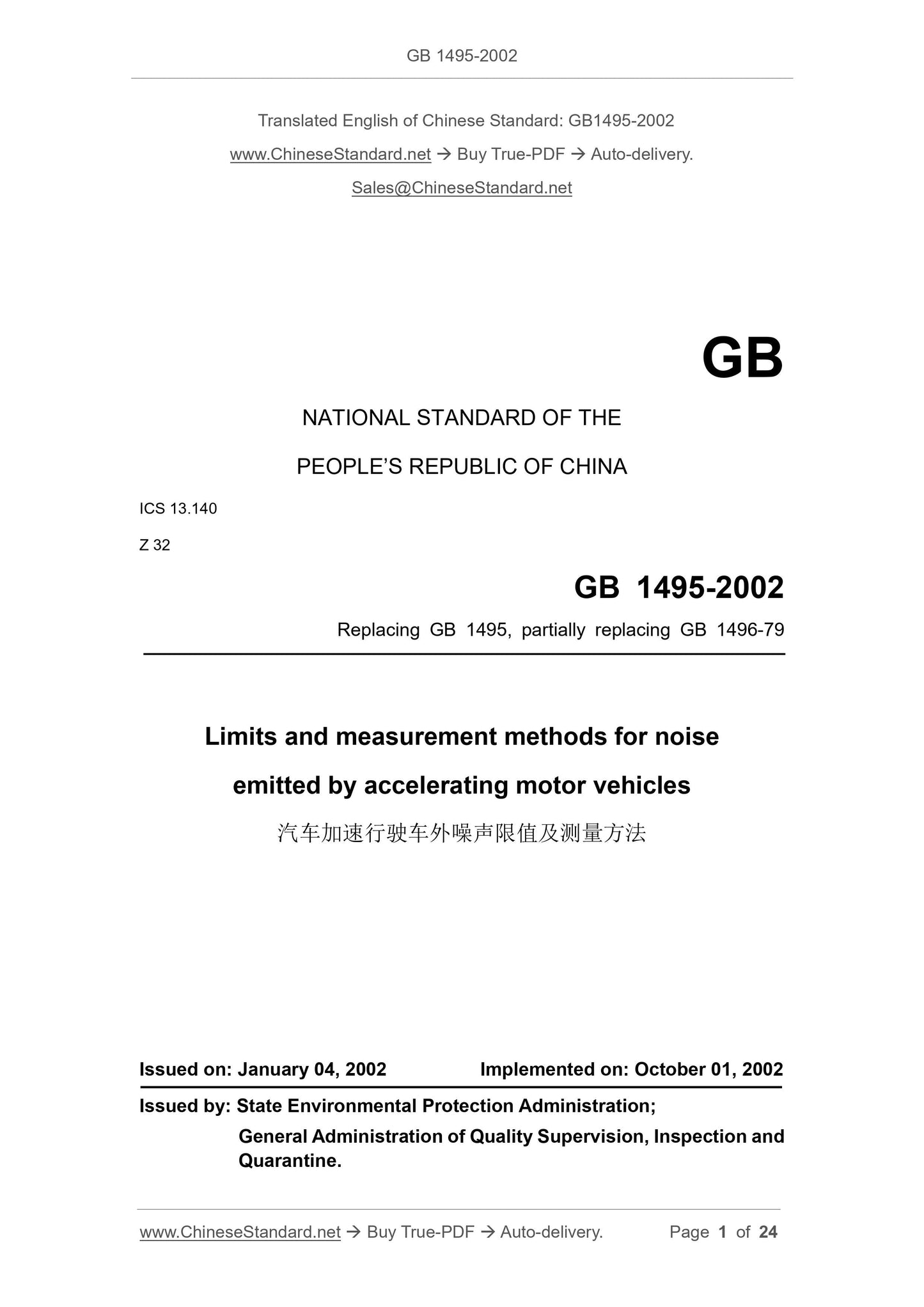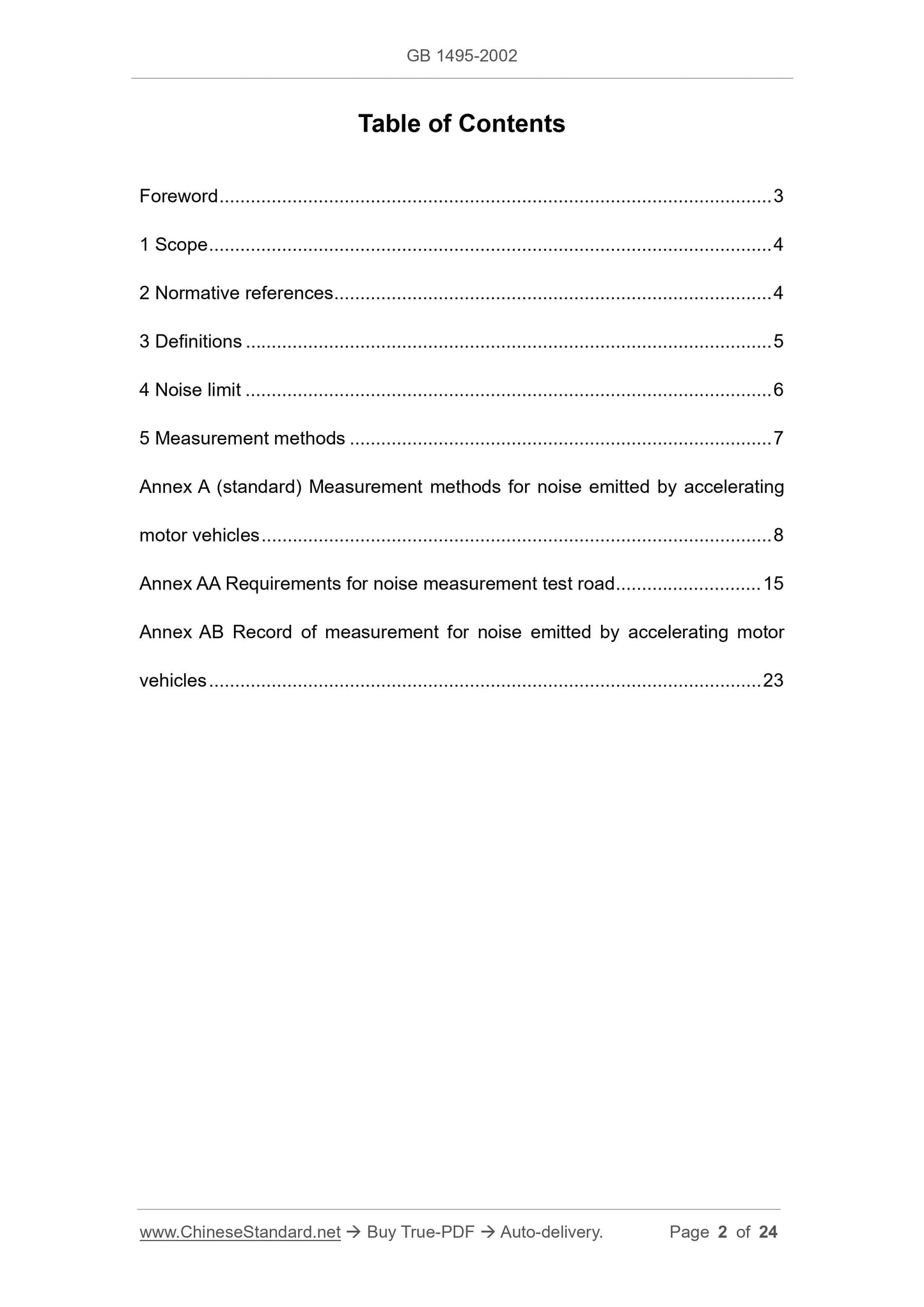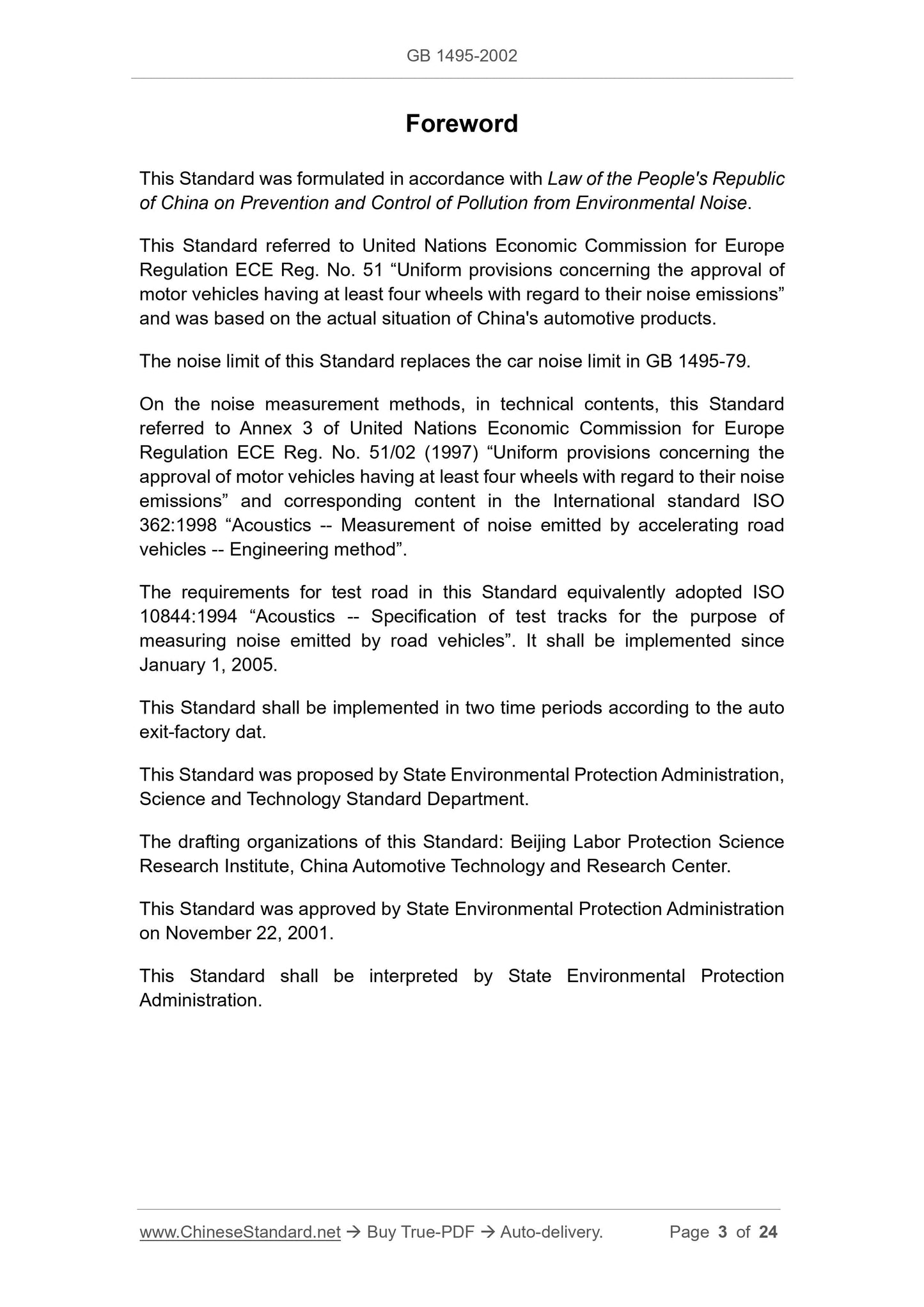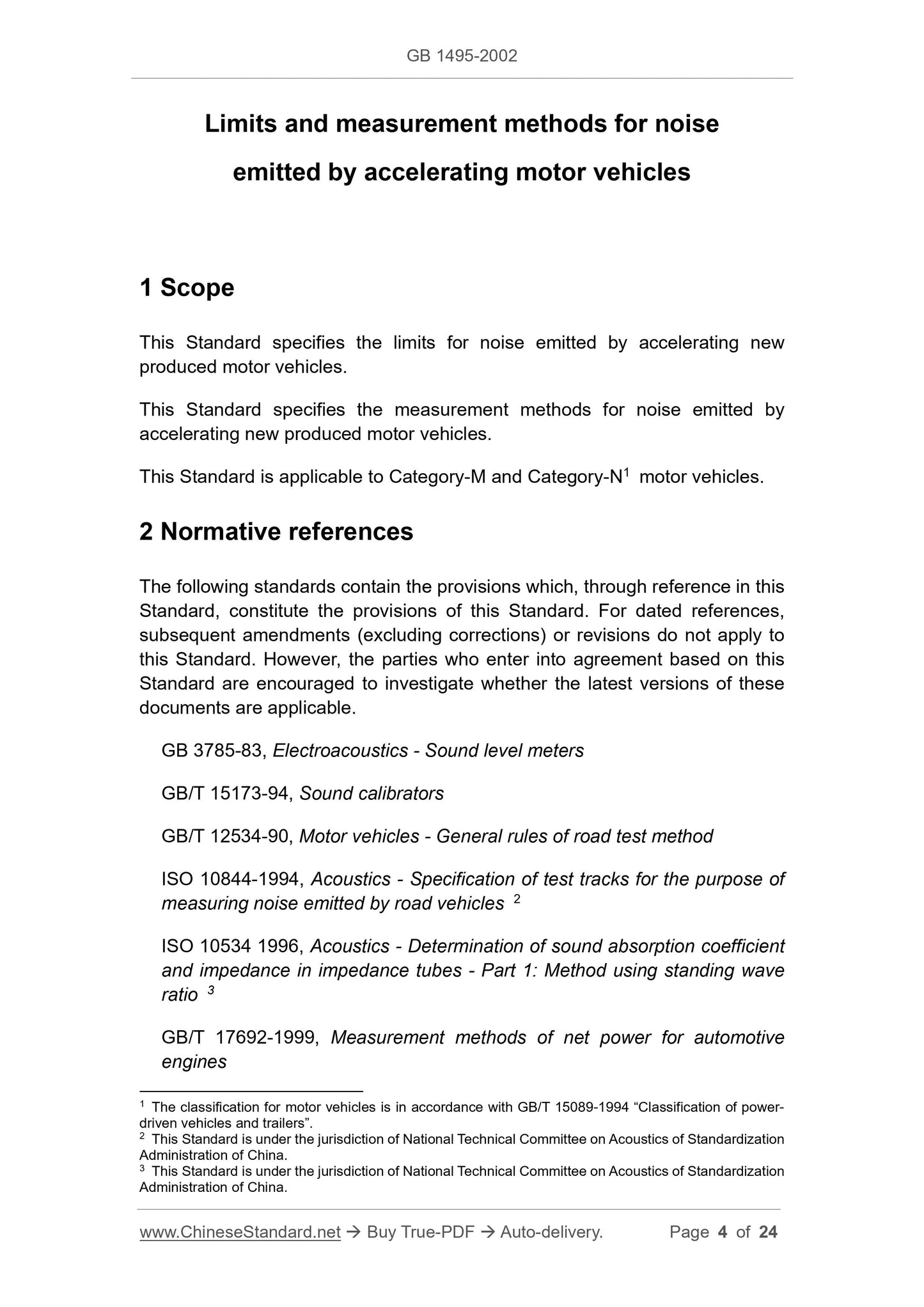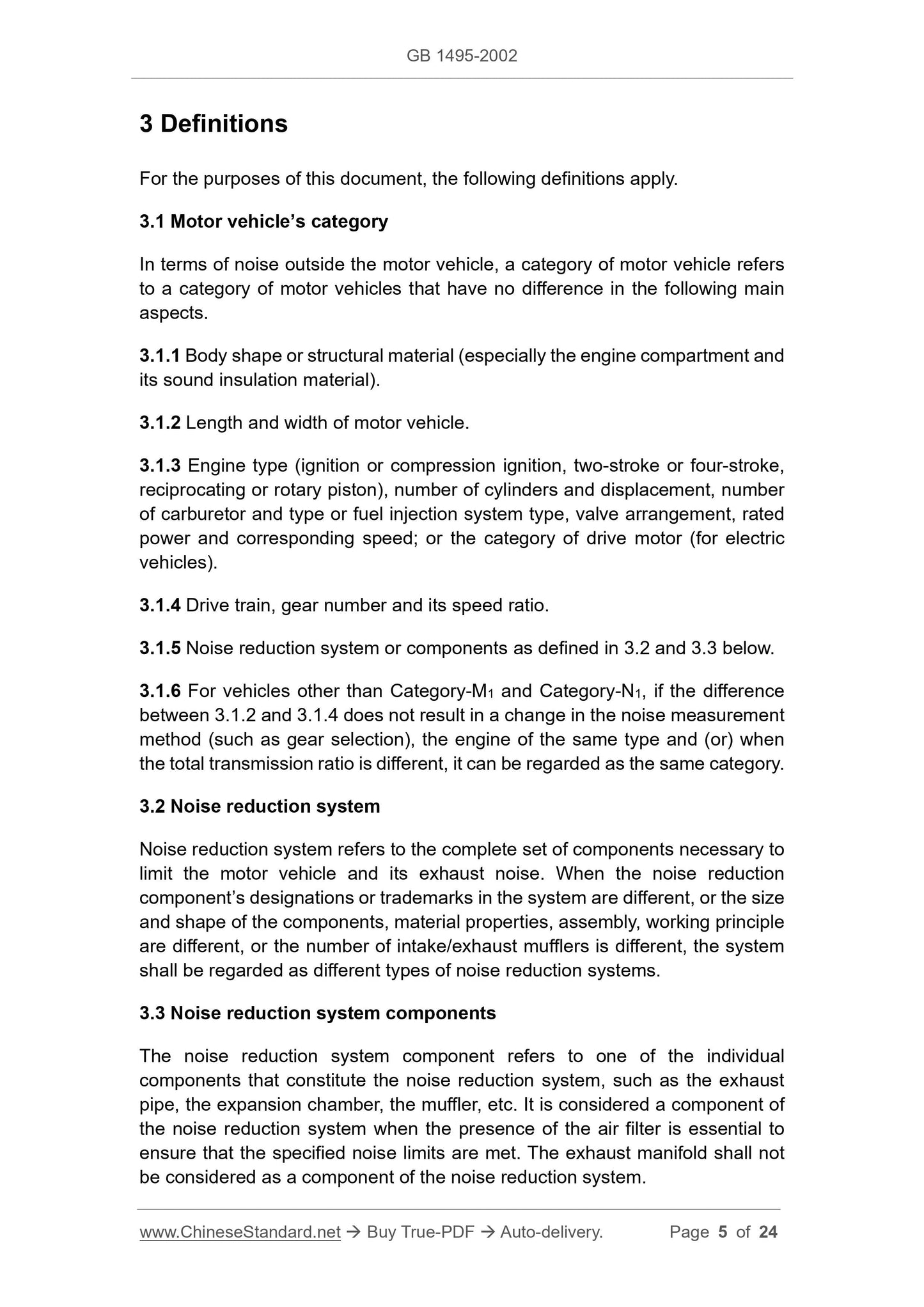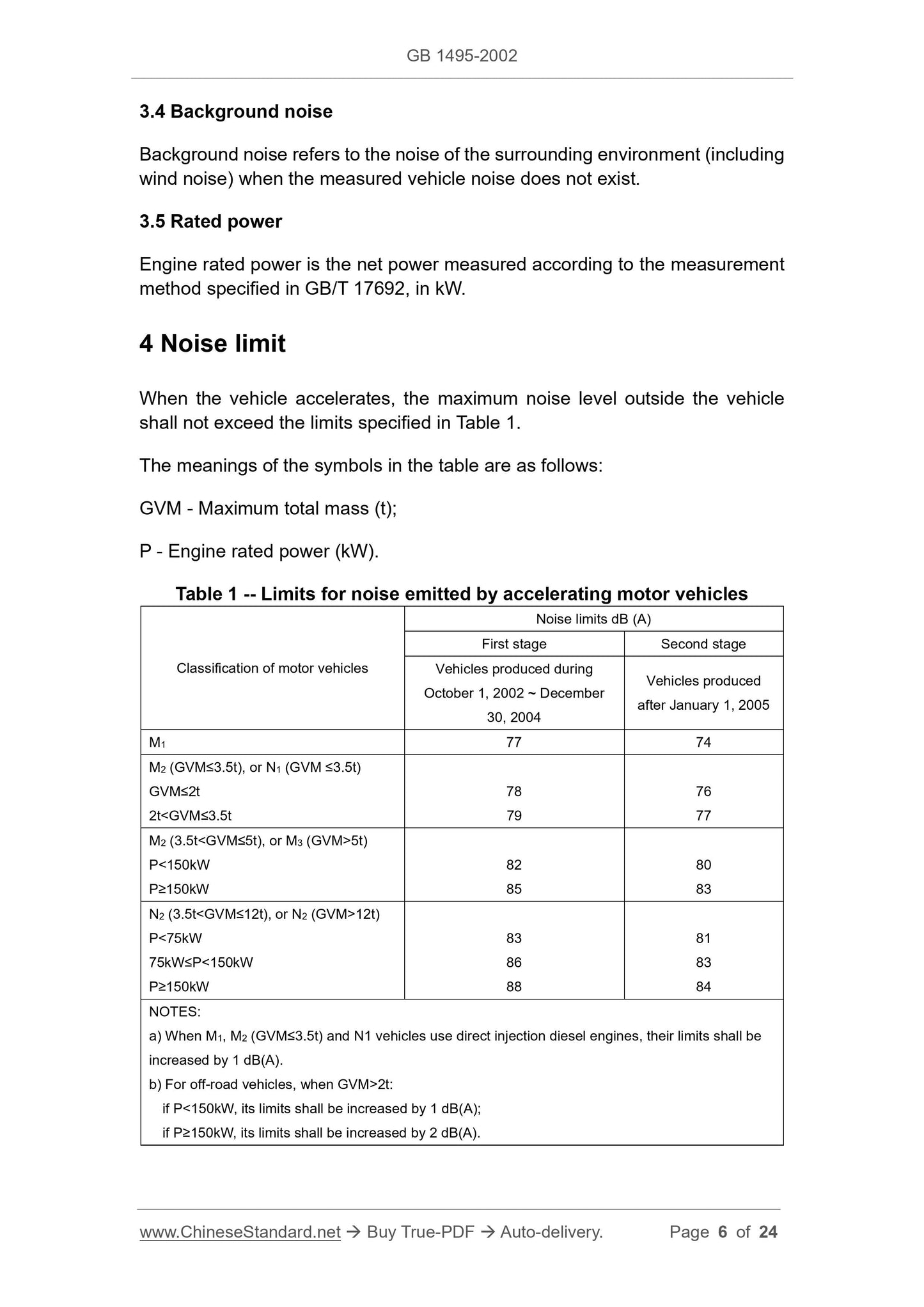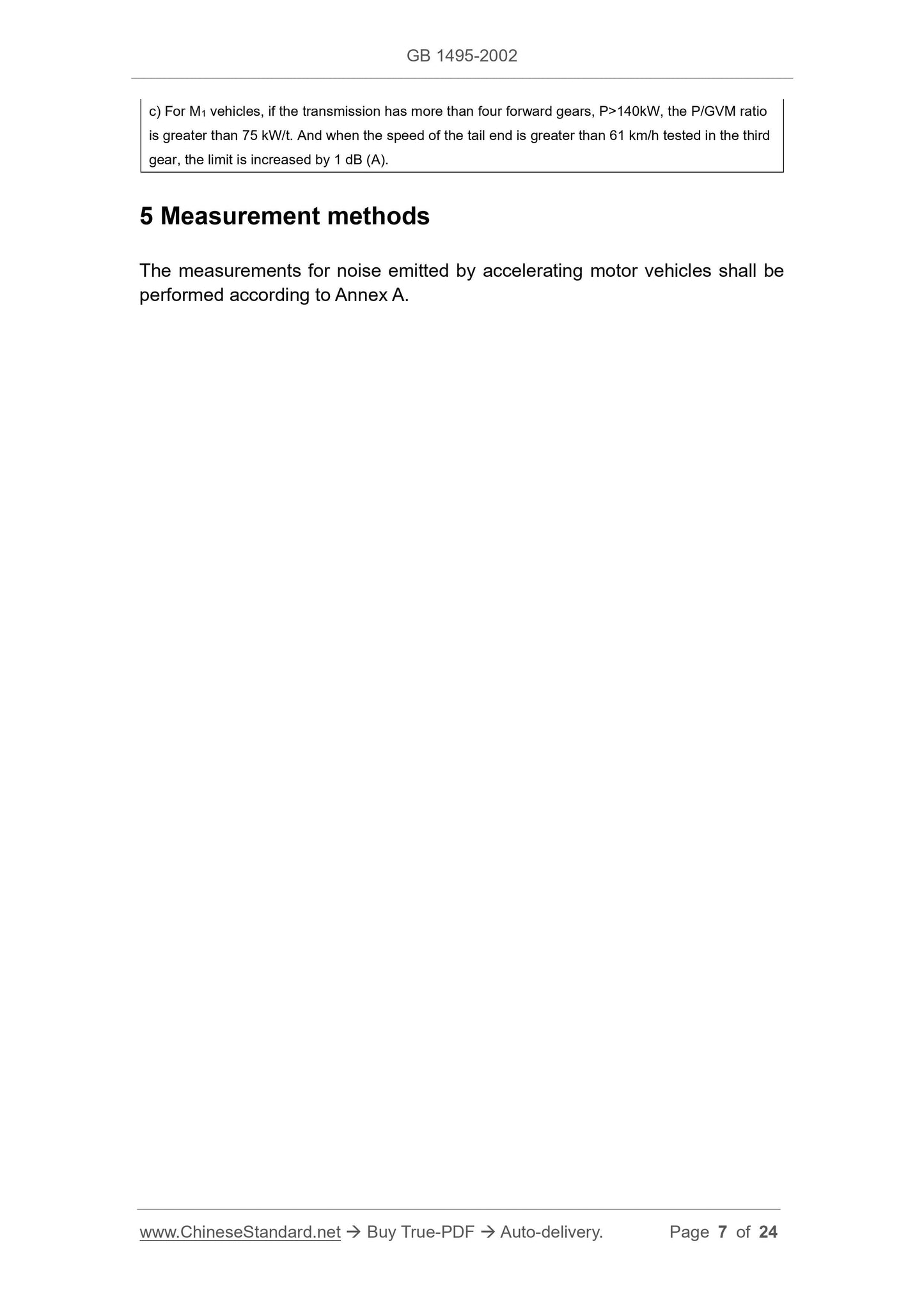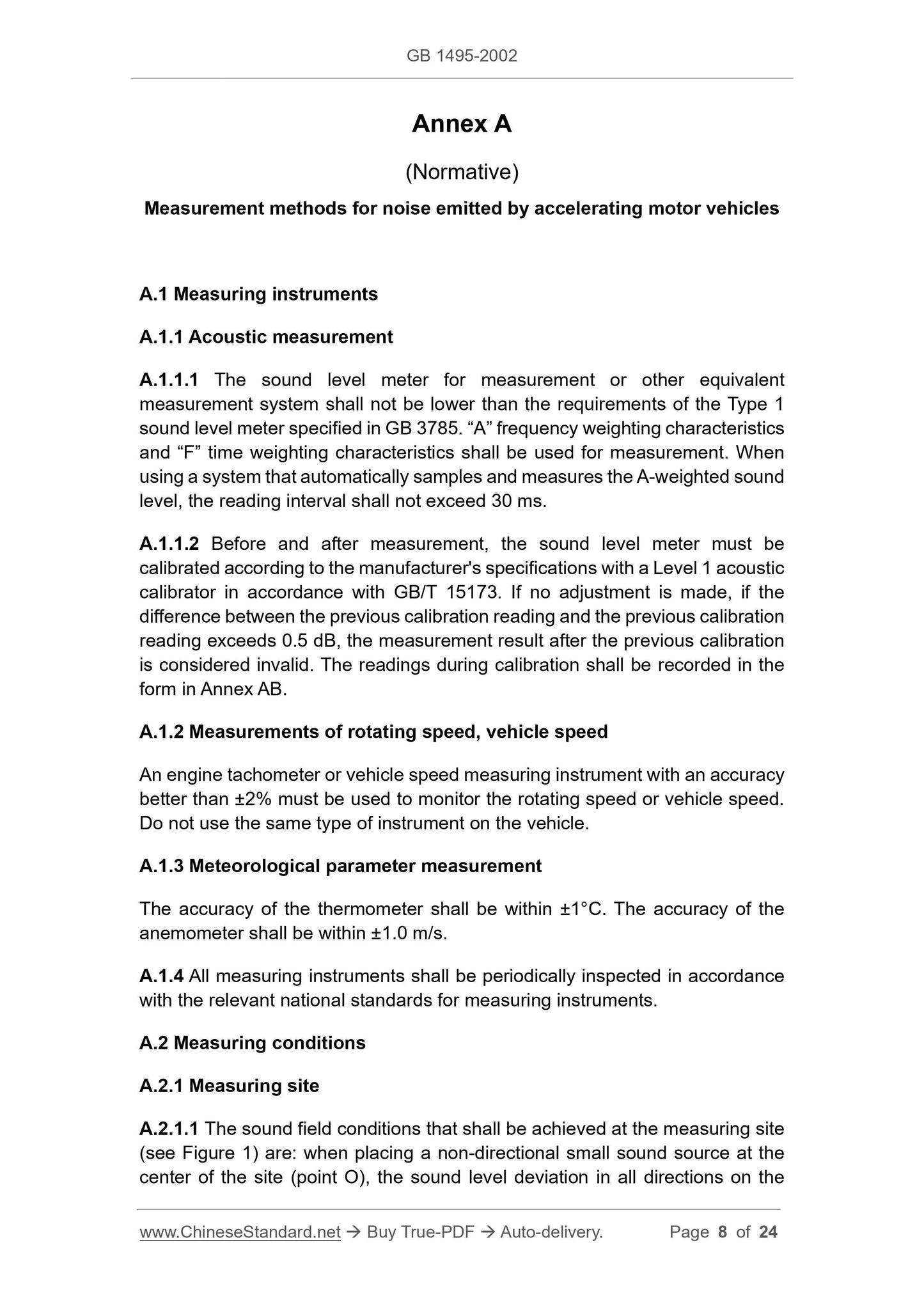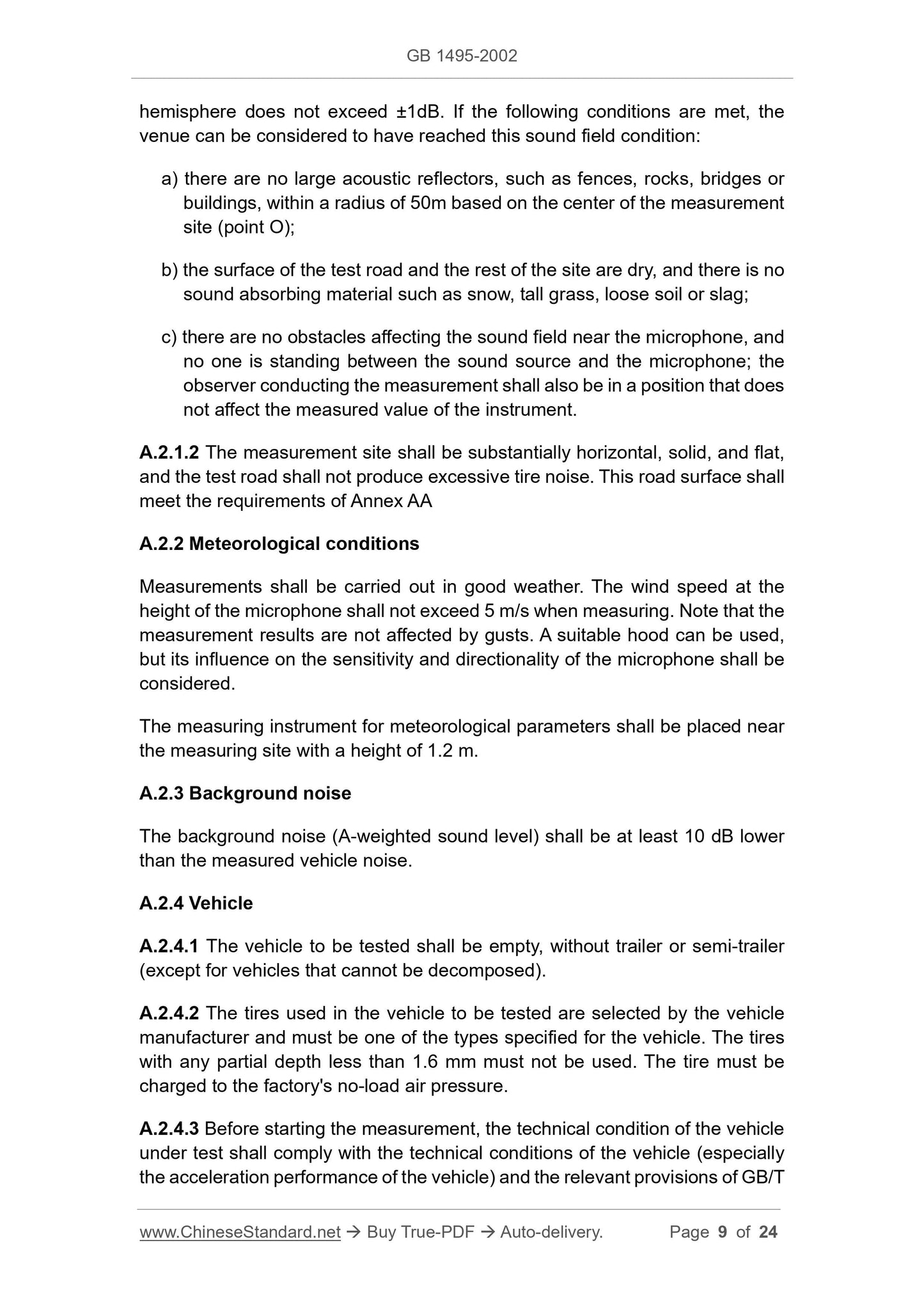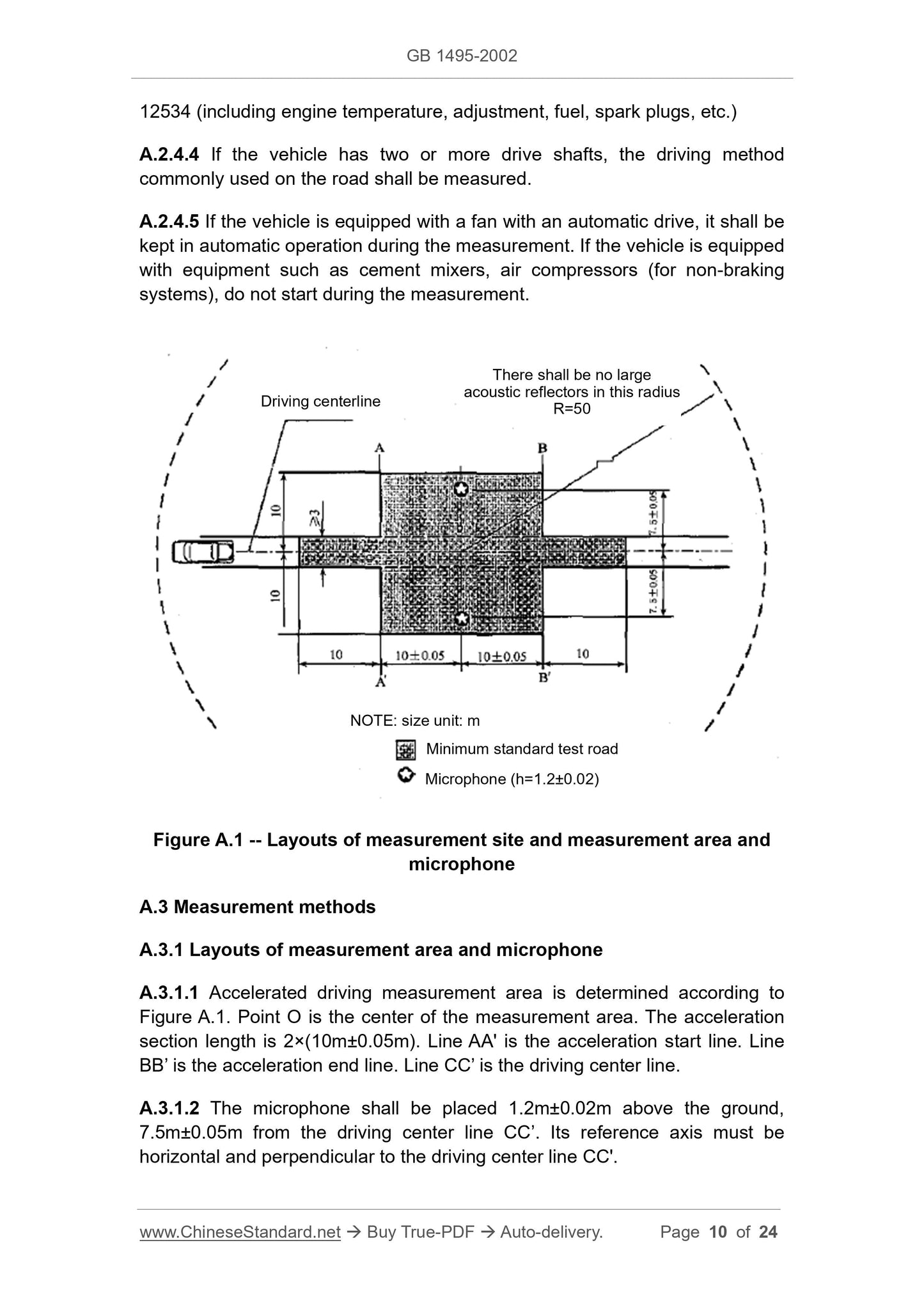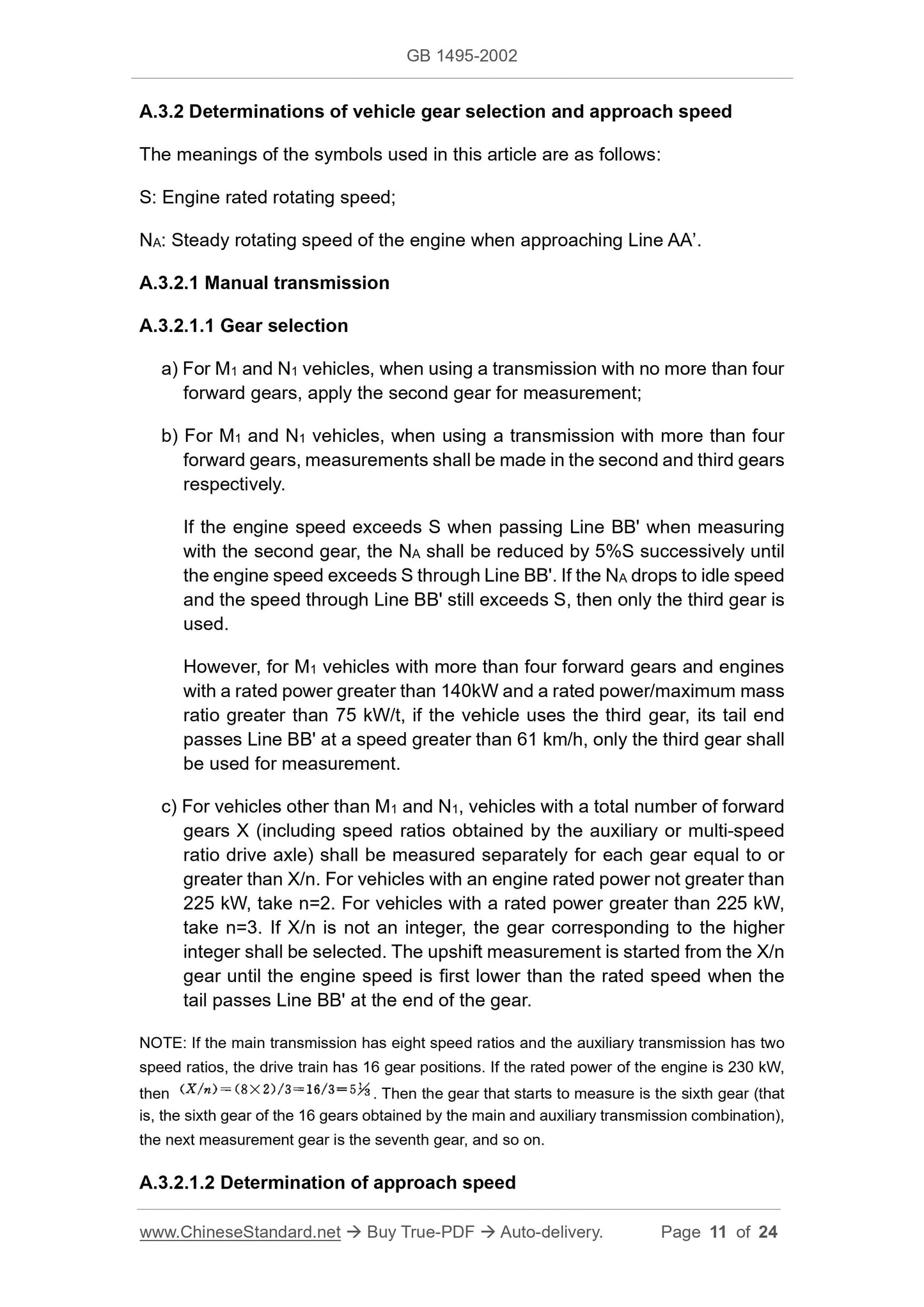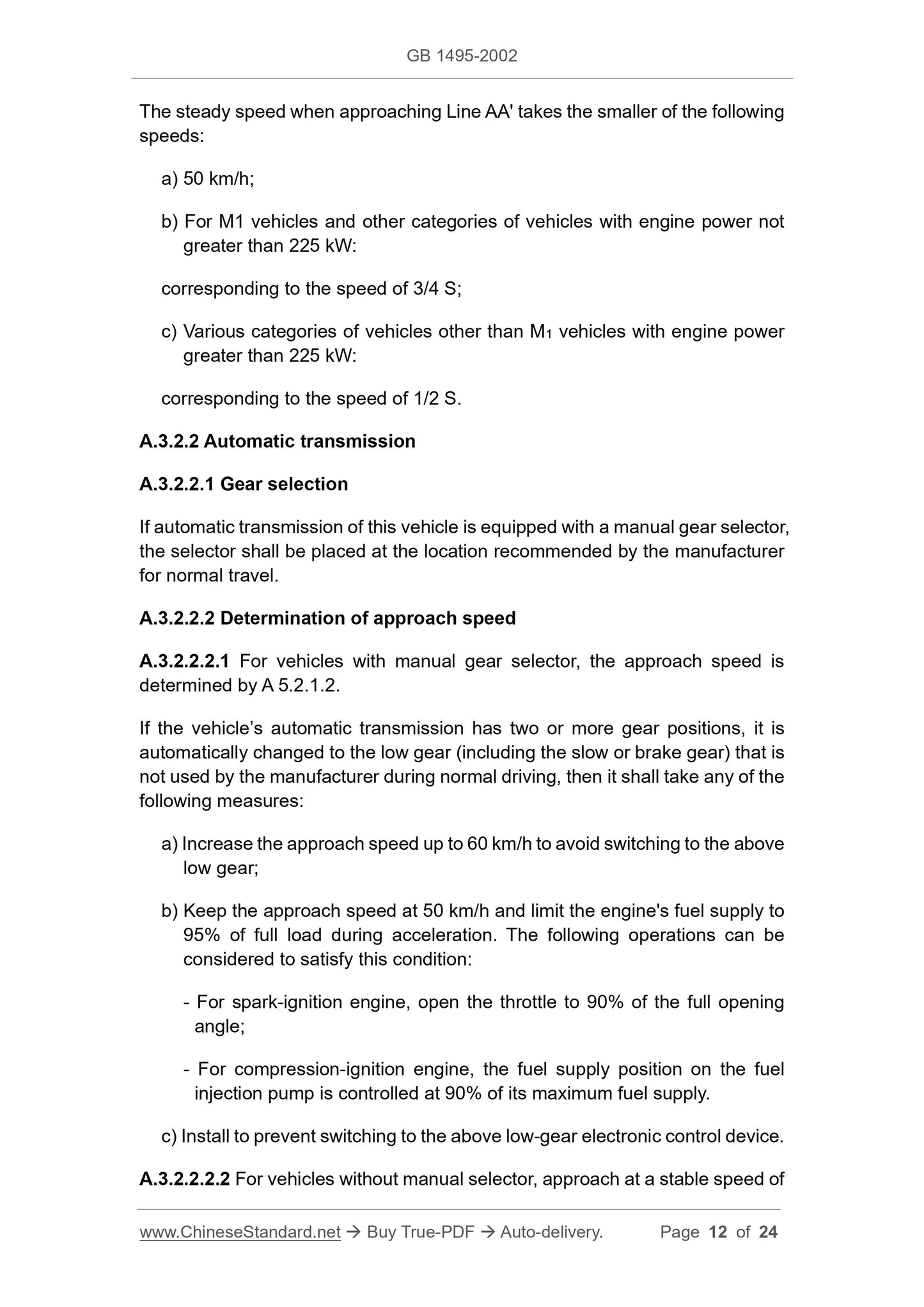1
/
of
12
www.ChineseStandard.us -- Field Test Asia Pte. Ltd.
GB 1495-2002 English PDF
GB 1495-2002 English PDF
Regular price
$145.00
Regular price
Sale price
$145.00
Unit price
/
per
Shipping calculated at checkout.
Couldn't load pickup availability
GB 1495-2002: Limits and measurement methods for noise emitted by accelerating motor vehicles
Delivery: 9 seconds. Download (& Email) true-PDF + Invoice.
Get Quotation: Click GB 1495-2002 (Self-service in 1-minute)
Historical versions (Master-website): GB 1495-2002
Preview True-PDF (Reload/Scroll-down if blank)
GB 1495-2002
GB
NATIONAL STANDARD OF THE
PEOPLE’S REPUBLIC OF CHINA
ICS 13.140
Z 32
Replacing GB 1495, partially replacing GB 1496-79
Limits and measurement methods for noise
emitted by accelerating motor vehicles
ISSUED ON. JANUARY 04, 2002
IMPLEMENTED ON. OCTOBER 01, 2002
Issued by. State Environmental Protection Administration;
General Administration of Quality Supervision, Inspection and
Quarantine.
Table of Contents
Foreword ... 3
1 Scope ... 4
2 Normative references ... 4
3 Definitions ... 5
4 Noise limit ... 6
5 Measurement methods ... 7
Annex A (standard) Measurement methods for noise emitted by accelerating
motor vehicles ... 8
Annex AA Requirements for noise measurement test road ... 15
Annex AB Record of measurement for noise emitted by accelerating motor
vehicles ... 23
Limits and measurement methods for noise
emitted by accelerating motor vehicles
1 Scope
This Standard specifies the limits for noise emitted by accelerating new
produced motor vehicles.
This Standard specifies the measurement methods for noise emitted by
accelerating new produced motor vehicles.
This Standard is applicable to Category-M and Category-N1 motor vehicles.
2 Normative references
The following standards contain the provisions which, through reference in this
Standard, constitute the provisions of this Standard. For dated references,
subsequent amendments (excluding corrections) or revisions do not apply to
this Standard. However, the parties who enter into agreement based on this
Standard are encouraged to investigate whether the latest versions of these
documents are applicable.
GB 3785-83, Electroacoustics - Sound level meters
GB/T 15173-94, Sound calibrators
GB/T 12534-90, Motor vehicles - General rules of road test method
ISO 10844-1994, Acoustics - Specification of test tracks for the purpose of
measuring noise emitted by road vehicles 2
ISO 10534 1996, Acoustics - Determination of sound absorption coefficient
and impedance in impedance tubes - Part 1. Method using standing wave
ratio 3
GB/T 17692-1999, Measurement methods of net power for automotive
engines
1 The classification for motor vehicles is in accordance with GB/T 15089-1994 “Classification of power-
driven vehicles and trailers”.
2 This Standard is under the jurisdiction of National Technical Committee on Acoustics of Standardization
Administration of China.
3 This Standard is under the jurisdiction of National Technical Committee on Acoustics of Standardization
Administration of China.
3 Definitions
For the purposes of this document, the following definitions apply.
3.1 Motor vehicle’s category
In terms of noise outside the motor vehicle, a category of motor vehicle refers
to a category of motor vehicles that have no difference in the following main
aspects.
3.1.1 Body shape or structural material (especially the engine compartment and
its sound insulation material).
3.1.2 Length and width of motor vehicle.
3.1.3 Engine type (ignition or compression ignition, two-stroke or four-stroke,
reciprocating or rotary piston), number of cylinders and displacement, number
of carburetor and type or fuel injection system type, valve arrangement, rated
power and corresponding speed; or the category of drive motor (for electric
vehicles).
3.1.4 Drive train, gear number and its speed ratio.
3.1.5 Noise reduction system or components as defined in 3.2 and 3.3 below.
3.1.6 For vehicles other than Category-M1 and Category-N1, if the difference
between 3.1.2 and 3.1.4 does not result in a change in the noise measurement
method (such as gear selection), the engine of the same type and (or) when
the total transmission ratio is different, it can be regarded as the same category.
3.2 Noise reduction system
Noise reduction system refers to the complete set of components necessary to
limit the motor vehicle and its exhaust noise. When the noise reduction
component’s designations or trademarks in the system are different, or the size
and shape of the components, material properties, assembly, working principle
are different, or the number of intake/exhaust mufflers is different, the system
shall be regarded as different types of noise reduction systems.
3.3 Noise reduction system components
The noise reduction system component refers to one of the individual
components that constitute the noise reduction system, such as the exhaust
pipe, the expansion chamber, the muffler, etc. It is considered a component of
the noise reduction system when the presence of the air filter is essential to
ensure that the specified noise limits are met. The exhaust manifold shall not
be considered as a component of the noise reduction system.
Annex A
(Normative)
Measurement methods for noise emitted by accelerating motor vehicles
A.1 Measuring instruments
A.1.1 Acoustic measurement
A.1.1.1 The sound level meter for measurement or other equivalent
measurement system shall not be lower than the requirements of the Type 1
sound level meter specified in GB 3785. “A” frequency weighting characteristics
and “F” time weighting characteristics shall be used for measurement. When
using a system that automatically samples and measures the A-weighted sound
level, the reading interval shall not exceed 30 ms.
A.1.1.2 Before and after measurement, the sound level meter must be
calibrated according to the manufacturer's specifications with a Level 1 acoustic
calibrator in accordance with GB/T 15173. If no adjustment is made, if the
difference between the previous calibration reading and the previous calibration
reading exceeds 0.5 dB, the measurement result after the previous calibration
is considered invalid. The readings during calibration shall be recorded in the
form in Annex AB.
A.1.2 Measurements of rotating speed, vehicle speed
An engine tachometer or vehicle speed measuring instrument with an accuracy
better than ±2% must be used to monitor the rotating speed or vehicle speed.
Do not use the same type of instrument on the vehicle.
A.1.3 Meteorological parameter measurement
The accuracy of the thermometer shall be within ±1°C. The accuracy of the
anemometer shall be within ±1.0 m/s.
A.1.4 All measuring instruments shall be periodically inspected in accordance
with the relevant national standards for measuring instruments.
A.2 Measuring conditions
A.2.1 Measuring site
A.2.1.1 The sound field conditions that shall be achieved at the measuring site
(see Figure 1) are. when placing a non-directional small sound source at the
center of the site (point O), the sound level deviation in all directions on the
hemisphere does not exceed ±1dB. If the following conditions are met, the
venue can be considered to have reached this sound field condition.
a) there are no large acoustic reflectors, such as fences, rocks, bridges or
buildings, within a radius of 50m based on the center of the measurement
site (point O);
b) the surface of the test road and the rest of the site are dry, and there is no
sound absorbing material such as snow, tall grass, loose soil or slag;
c) there are no obstacles affecting the sound field near the microphone, and
no one is standing between the sound source and the microphone; the
observer conducting the measurement shall also be in a position that does
not affect the measured value of the instrument.
A.2.1.2 The measurement site shall be substantially horizontal, solid, and flat,
and the test road shall not produce excessive tire noise. This road surface shall
meet the requirements of Annex AA
A.2.2 Meteorological conditions
Measurements shall be carried out in good weather. The wind speed at the
height of the microphone shall not exceed 5 m/s when measuring. Note that the
measurement results are not affected by gusts. A suitable hood can be used,
but its influence on the sensitivity and directionality of the microphone shall be
considered.
The measuring instrument for meteorological parameters shall be placed near
the measuring site with a height of 1.2 m.
A.2.3 Background noise
The background noise (A-weighted sound level) shall be at least 10 dB lower
than the measured vehicle noise.
A.2.4 Vehicle
A.2.4.1 The vehicle to be tested shall be empty, without trailer or semi-trailer
(except for vehicles that cannot be decomposed).
A.2.4.2 The tires used in the vehicle to be tested are selected by the vehicle
manufacturer and must be one of the types specified for the vehicle. The tires
with any partial depth less than 1.6 mm must not be used. The tire must be
charged to the factory's no-load air pressure.
A.2.4.3 Before starting the measurement, the technical condition of the vehicle
under test shall comply with the technical conditions of the vehicle (especially
the acceleration performance of the vehicle) and the relevant provisions of GB/T
A.3.2 Determinations of vehicle gear selection and approach speed
The meanings of the symbols used in this article are as follows.
S. Engine rated rotating speed;
NA. Steady rotating speed of the engine when approaching Line AA’.
A.3.2.1 Manual transmission
A.3.2.1.1 Gear selection
a) For M1 and N1 vehicles, when using a transmission with no more than four
forward gears, apply the second gear for measurement;
b) For M1 and N1 vehicles, when using a transmission with more than four
forward gears, measurements shall be made in the second and third gears
respectively.
If the engine speed exceeds S when passing Line BB' when measuring
with the second gear, the NA shall be reduced by 5%S successively until
the engine speed exceeds S through Line BB'. If the NA drops to idle speed
and the speed through Line BB' still exceeds S, then only the third gear is
used.
However, for M1 vehicles with more than four forward gears and engines
with a rated power greater than 140kW and a rated power/maximum mass
ratio greater than 75 kW/t, if the vehicle uses the third gear, its tail end
passes Line BB' at a speed greater than 61 km/h, only the third gear shall
be used for measurement.
c) For vehicles other than M1 and N1, vehicles with a total number of forward
gears X (including speed ratios obtained by the auxiliary or multi-speed
ratio drive axle) shall be measured separately for each gear equal to or
greater than X/n. For vehicles with an engine rated power not greater than
225 kW, take n=2. For vehicles with a rated power greater than 225 kW,
take n=3. If X/n is not an integer, the gear corresponding to the higher
integer shall be selected. The upshift measurement is started from the X/n
gear until the engine speed is first lower than the rated speed when the
tail passes Line BB' at the end of the gear.
NOTE. If the main transmission has eight speed ratios and the auxiliary transmission has two
speed ratios, the drive train has 16 gear positions. If the rated power of the engine is 230 kW,
then . Then the gear that starts to measure is the sixth gear (that
is, the sixth gear of the 16 gears obtained by the main and auxiliary transmission combination),
the next measurement gear is the seventh gear, and so on.
A.3.2.1.2 Determination of approach speed
30, 40, 50 km/h (if the maximum speed of the lane is less than 50 km/h, the
maximum speed is 3/4) to Line AA'.
A.3.3 Accelerated driving operation
A.3.3.1 The vehicle shall approach Line AA' at the gear position and steady
speed specified above, and its speed change shall be controlled within ±1 km/h.
If the engine speed is controlled, the speed change shall be controlled within
±2% or ±50 r/min (whichever is greater).
A.3.3.2 When the front end of the vehicle reaches Line AA', the accelerator
pedal must be stepped as quickly as possible (i.e., the throttle or accelerator is
fully open) and remain unchanged until the rear end of the vehicle passes Line
BB' and then the pedal is released as quickly as possible (that is, the throttle or
accelerator is closed).
A.3.3.3 The vehicle shall accelerate in a straight line through the measuring
area, and its longitudinal center plane shall be as close as possible to the center
Line CC'.
A.3.3.4 If the vehicle is composed of a tractor and a trailer that is not easily
separated, it is determined that the tail end does not consider the trailer when
passing Line BB'.
A.3.4 Sound level measurement
A.3.4.1 At least four measurements shall be performed on each side of the
vehicle.
A.3.4.2 The maximum sound level of the vehicle that accelerates through the
measurement area shall be measured. The measured value of each
measurement shall be subtracted by 1 dB(A) as the measurement result.
A.3.4.3 If the difference between four consecutive measurements on the same
side of the vehicle is not more than 2 dB (A), the measurement is considered
valid.
A.3.4.4 Take arithmetic average of four measurements on each side under each
gear (or near speed) condition. Then take the larger of the averages on two
sides as the intermediate result.
A.3.5 Determination of maximum noise level of vehicle
A.3.5.1 Corresponding to the gear condition of a) in A.3.2.1.1, directly take the
intermediate result as the maximum noise level.
A.3.5.2 Corresponding to the gear condition of b) in A.3.2.1.1, if the second and
third gears are used, the arithmetic mean of the intermediate results of the two
Annex AA
Requirements for noise measurement test road
AA1 Introduction
This Annex, based on the main content of ISO 10844.1994 “Acoustics --
Specification of test tracks for the purpose of measuring noise emitted by road
vehicles”, specifies technical requirements for test road construction and
physical properties to be achieved and their measurement methods.
AA2 Terms
This Annex adopts the following terms.
AA2.1 Void ratio
Void ratio refers to the percentage of pore volume between aggregates in road
concrete to the total volume of concrete, expressed as Ve. These pores are
either interconnected (closed pores) or open to the surrounding atmos...
Delivery: 9 seconds. Download (& Email) true-PDF + Invoice.
Get Quotation: Click GB 1495-2002 (Self-service in 1-minute)
Historical versions (Master-website): GB 1495-2002
Preview True-PDF (Reload/Scroll-down if blank)
GB 1495-2002
GB
NATIONAL STANDARD OF THE
PEOPLE’S REPUBLIC OF CHINA
ICS 13.140
Z 32
Replacing GB 1495, partially replacing GB 1496-79
Limits and measurement methods for noise
emitted by accelerating motor vehicles
ISSUED ON. JANUARY 04, 2002
IMPLEMENTED ON. OCTOBER 01, 2002
Issued by. State Environmental Protection Administration;
General Administration of Quality Supervision, Inspection and
Quarantine.
Table of Contents
Foreword ... 3
1 Scope ... 4
2 Normative references ... 4
3 Definitions ... 5
4 Noise limit ... 6
5 Measurement methods ... 7
Annex A (standard) Measurement methods for noise emitted by accelerating
motor vehicles ... 8
Annex AA Requirements for noise measurement test road ... 15
Annex AB Record of measurement for noise emitted by accelerating motor
vehicles ... 23
Limits and measurement methods for noise
emitted by accelerating motor vehicles
1 Scope
This Standard specifies the limits for noise emitted by accelerating new
produced motor vehicles.
This Standard specifies the measurement methods for noise emitted by
accelerating new produced motor vehicles.
This Standard is applicable to Category-M and Category-N1 motor vehicles.
2 Normative references
The following standards contain the provisions which, through reference in this
Standard, constitute the provisions of this Standard. For dated references,
subsequent amendments (excluding corrections) or revisions do not apply to
this Standard. However, the parties who enter into agreement based on this
Standard are encouraged to investigate whether the latest versions of these
documents are applicable.
GB 3785-83, Electroacoustics - Sound level meters
GB/T 15173-94, Sound calibrators
GB/T 12534-90, Motor vehicles - General rules of road test method
ISO 10844-1994, Acoustics - Specification of test tracks for the purpose of
measuring noise emitted by road vehicles 2
ISO 10534 1996, Acoustics - Determination of sound absorption coefficient
and impedance in impedance tubes - Part 1. Method using standing wave
ratio 3
GB/T 17692-1999, Measurement methods of net power for automotive
engines
1 The classification for motor vehicles is in accordance with GB/T 15089-1994 “Classification of power-
driven vehicles and trailers”.
2 This Standard is under the jurisdiction of National Technical Committee on Acoustics of Standardization
Administration of China.
3 This Standard is under the jurisdiction of National Technical Committee on Acoustics of Standardization
Administration of China.
3 Definitions
For the purposes of this document, the following definitions apply.
3.1 Motor vehicle’s category
In terms of noise outside the motor vehicle, a category of motor vehicle refers
to a category of motor vehicles that have no difference in the following main
aspects.
3.1.1 Body shape or structural material (especially the engine compartment and
its sound insulation material).
3.1.2 Length and width of motor vehicle.
3.1.3 Engine type (ignition or compression ignition, two-stroke or four-stroke,
reciprocating or rotary piston), number of cylinders and displacement, number
of carburetor and type or fuel injection system type, valve arrangement, rated
power and corresponding speed; or the category of drive motor (for electric
vehicles).
3.1.4 Drive train, gear number and its speed ratio.
3.1.5 Noise reduction system or components as defined in 3.2 and 3.3 below.
3.1.6 For vehicles other than Category-M1 and Category-N1, if the difference
between 3.1.2 and 3.1.4 does not result in a change in the noise measurement
method (such as gear selection), the engine of the same type and (or) when
the total transmission ratio is different, it can be regarded as the same category.
3.2 Noise reduction system
Noise reduction system refers to the complete set of components necessary to
limit the motor vehicle and its exhaust noise. When the noise reduction
component’s designations or trademarks in the system are different, or the size
and shape of the components, material properties, assembly, working principle
are different, or the number of intake/exhaust mufflers is different, the system
shall be regarded as different types of noise reduction systems.
3.3 Noise reduction system components
The noise reduction system component refers to one of the individual
components that constitute the noise reduction system, such as the exhaust
pipe, the expansion chamber, the muffler, etc. It is considered a component of
the noise reduction system when the presence of the air filter is essential to
ensure that the specified noise limits are met. The exhaust manifold shall not
be considered as a component of the noise reduction system.
Annex A
(Normative)
Measurement methods for noise emitted by accelerating motor vehicles
A.1 Measuring instruments
A.1.1 Acoustic measurement
A.1.1.1 The sound level meter for measurement or other equivalent
measurement system shall not be lower than the requirements of the Type 1
sound level meter specified in GB 3785. “A” frequency weighting characteristics
and “F” time weighting characteristics shall be used for measurement. When
using a system that automatically samples and measures the A-weighted sound
level, the reading interval shall not exceed 30 ms.
A.1.1.2 Before and after measurement, the sound level meter must be
calibrated according to the manufacturer's specifications with a Level 1 acoustic
calibrator in accordance with GB/T 15173. If no adjustment is made, if the
difference between the previous calibration reading and the previous calibration
reading exceeds 0.5 dB, the measurement result after the previous calibration
is considered invalid. The readings during calibration shall be recorded in the
form in Annex AB.
A.1.2 Measurements of rotating speed, vehicle speed
An engine tachometer or vehicle speed measuring instrument with an accuracy
better than ±2% must be used to monitor the rotating speed or vehicle speed.
Do not use the same type of instrument on the vehicle.
A.1.3 Meteorological parameter measurement
The accuracy of the thermometer shall be within ±1°C. The accuracy of the
anemometer shall be within ±1.0 m/s.
A.1.4 All measuring instruments shall be periodically inspected in accordance
with the relevant national standards for measuring instruments.
A.2 Measuring conditions
A.2.1 Measuring site
A.2.1.1 The sound field conditions that shall be achieved at the measuring site
(see Figure 1) are. when placing a non-directional small sound source at the
center of the site (point O), the sound level deviation in all directions on the
hemisphere does not exceed ±1dB. If the following conditions are met, the
venue can be considered to have reached this sound field condition.
a) there are no large acoustic reflectors, such as fences, rocks, bridges or
buildings, within a radius of 50m based on the center of the measurement
site (point O);
b) the surface of the test road and the rest of the site are dry, and there is no
sound absorbing material such as snow, tall grass, loose soil or slag;
c) there are no obstacles affecting the sound field near the microphone, and
no one is standing between the sound source and the microphone; the
observer conducting the measurement shall also be in a position that does
not affect the measured value of the instrument.
A.2.1.2 The measurement site shall be substantially horizontal, solid, and flat,
and the test road shall not produce excessive tire noise. This road surface shall
meet the requirements of Annex AA
A.2.2 Meteorological conditions
Measurements shall be carried out in good weather. The wind speed at the
height of the microphone shall not exceed 5 m/s when measuring. Note that the
measurement results are not affected by gusts. A suitable hood can be used,
but its influence on the sensitivity and directionality of the microphone shall be
considered.
The measuring instrument for meteorological parameters shall be placed near
the measuring site with a height of 1.2 m.
A.2.3 Background noise
The background noise (A-weighted sound level) shall be at least 10 dB lower
than the measured vehicle noise.
A.2.4 Vehicle
A.2.4.1 The vehicle to be tested shall be empty, without trailer or semi-trailer
(except for vehicles that cannot be decomposed).
A.2.4.2 The tires used in the vehicle to be tested are selected by the vehicle
manufacturer and must be one of the types specified for the vehicle. The tires
with any partial depth less than 1.6 mm must not be used. The tire must be
charged to the factory's no-load air pressure.
A.2.4.3 Before starting the measurement, the technical condition of the vehicle
under test shall comply with the technical conditions of the vehicle (especially
the acceleration performance of the vehicle) and the relevant provisions of GB/T
A.3.2 Determinations of vehicle gear selection and approach speed
The meanings of the symbols used in this article are as follows.
S. Engine rated rotating speed;
NA. Steady rotating speed of the engine when approaching Line AA’.
A.3.2.1 Manual transmission
A.3.2.1.1 Gear selection
a) For M1 and N1 vehicles, when using a transmission with no more than four
forward gears, apply the second gear for measurement;
b) For M1 and N1 vehicles, when using a transmission with more than four
forward gears, measurements shall be made in the second and third gears
respectively.
If the engine speed exceeds S when passing Line BB' when measuring
with the second gear, the NA shall be reduced by 5%S successively until
the engine speed exceeds S through Line BB'. If the NA drops to idle speed
and the speed through Line BB' still exceeds S, then only the third gear is
used.
However, for M1 vehicles with more than four forward gears and engines
with a rated power greater than 140kW and a rated power/maximum mass
ratio greater than 75 kW/t, if the vehicle uses the third gear, its tail end
passes Line BB' at a speed greater than 61 km/h, only the third gear shall
be used for measurement.
c) For vehicles other than M1 and N1, vehicles with a total number of forward
gears X (including speed ratios obtained by the auxiliary or multi-speed
ratio drive axle) shall be measured separately for each gear equal to or
greater than X/n. For vehicles with an engine rated power not greater than
225 kW, take n=2. For vehicles with a rated power greater than 225 kW,
take n=3. If X/n is not an integer, the gear corresponding to the higher
integer shall be selected. The upshift measurement is started from the X/n
gear until the engine speed is first lower than the rated speed when the
tail passes Line BB' at the end of the gear.
NOTE. If the main transmission has eight speed ratios and the auxiliary transmission has two
speed ratios, the drive train has 16 gear positions. If the rated power of the engine is 230 kW,
then . Then the gear that starts to measure is the sixth gear (that
is, the sixth gear of the 16 gears obtained by the main and auxiliary transmission combination),
the next measurement gear is the seventh gear, and so on.
A.3.2.1.2 Determination of approach speed
30, 40, 50 km/h (if the maximum speed of the lane is less than 50 km/h, the
maximum speed is 3/4) to Line AA'.
A.3.3 Accelerated driving operation
A.3.3.1 The vehicle shall approach Line AA' at the gear position and steady
speed specified above, and its speed change shall be controlled within ±1 km/h.
If the engine speed is controlled, the speed change shall be controlled within
±2% or ±50 r/min (whichever is greater).
A.3.3.2 When the front end of the vehicle reaches Line AA', the accelerator
pedal must be stepped as quickly as possible (i.e., the throttle or accelerator is
fully open) and remain unchanged until the rear end of the vehicle passes Line
BB' and then the pedal is released as quickly as possible (that is, the throttle or
accelerator is closed).
A.3.3.3 The vehicle shall accelerate in a straight line through the measuring
area, and its longitudinal center plane shall be as close as possible to the center
Line CC'.
A.3.3.4 If the vehicle is composed of a tractor and a trailer that is not easily
separated, it is determined that the tail end does not consider the trailer when
passing Line BB'.
A.3.4 Sound level measurement
A.3.4.1 At least four measurements shall be performed on each side of the
vehicle.
A.3.4.2 The maximum sound level of the vehicle that accelerates through the
measurement area shall be measured. The measured value of each
measurement shall be subtracted by 1 dB(A) as the measurement result.
A.3.4.3 If the difference between four consecutive measurements on the same
side of the vehicle is not more than 2 dB (A), the measurement is considered
valid.
A.3.4.4 Take arithmetic average of four measurements on each side under each
gear (or near speed) condition. Then take the larger of the averages on two
sides as the intermediate result.
A.3.5 Determination of maximum noise level of vehicle
A.3.5.1 Corresponding to the gear condition of a) in A.3.2.1.1, directly take the
intermediate result as the maximum noise level.
A.3.5.2 Corresponding to the gear condition of b) in A.3.2.1.1, if the second and
third gears are used, the arithmetic mean of the intermediate results of the two
Annex AA
Requirements for noise measurement test road
AA1 Introduction
This Annex, based on the main content of ISO 10844.1994 “Acoustics --
Specification of test tracks for the purpose of measuring noise emitted by road
vehicles”, specifies technical requirements for test road construction and
physical properties to be achieved and their measurement methods.
AA2 Terms
This Annex adopts the following terms.
AA2.1 Void ratio
Void ratio refers to the percentage of pore volume between aggregates in road
concrete to the total volume of concrete, expressed as Ve. These pores are
either interconnected (closed pores) or open to the surrounding atmos...
Share
